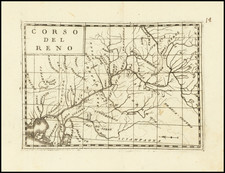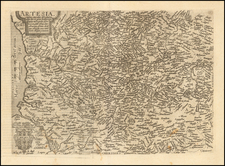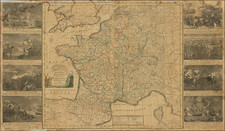Finely Colored Map of The Environs of Paris From the Libraryu of General Nicholas Charles Oudinot
Finely colored example of the Environs of Paris, from Cesar-Francois Cassini's monumental survey.
The Casinni Survey is one of the great works of 18th Century Cartographic History and a technical milestone in the history of science. As noted by David Rumsey
The Cassini Survey of France was the first national survey completed on the same scale, 100 toises (a toise was equal to 6ft and the equivalent scale today would be 1:86,400), according to a specific plan. It was led by several generations of the Cassini family starting in the 1740's and continuing through the French revolution and Napoleon's time, to 1815. Four generations of the Cassini family held the position of director of the Paris Observatory, and three of those worked on the Carte de France: Jacques Cassini (Cassini II, 1677-1756); Cesar-Francois Cassini (Cassini III, 1714-1784); and Jean Dominique Cassini (Cassini IV, 1748-1845).
The 182 sheets that comprise the map are superb examples of cartographic engraving. The use of trigonometric surveying techniques gave the map a high degree of accuracy for its time. The sheets can therefore be joined together to present a unified view of France in the 18th century.
General Nicolas Charles Oudinot
A final detail that gives this map particular importance is the identity of its former owner, Nicolas Charles Oudinot, 1st Comte Oudinot, 1st Duc de Reggio (1767 - 1848), and a Marshal of France. A fierce fighter, the man was wounded no less than 34 times during his military career!
The only one of nine siblings to live past childhood, Oudinot joined the army without a noble pedigree, and therefore without a chance of high promotion. That all changed in 1792, with the outbreak of the French Revolution. In that year, Oudinot was elected lieutenant-colonel of the third battalion of the volunteers of the Meuse. After transfer to the regular army and admirable service in Belgium, he was promoted to the rank of general in June 1794 after the Battle of Kaiserslautern.
From Belgium he shifted to the German and Swiss fronts, where he fought as a general of division and chief of staff to Andre Massena. Oudinot stood out at the Battle of Monzambano so much so that Napoleon himself presented him with a sword of honor, now known as the Legion d'Honneur. Napoleon did not forget him after he established his empire; now Emperor Napoleon recognized Oudinot again, this time with a Grand Cross of the Legion of Honor.
During the Napoleonic Wars, Oudinot continued to acquit himself commendably. He was elected a member of the Chamber of Deputies, commanded a company of grenadiers nicknamed for him, and fought in battles from Vienna to Poland. In 1808, he was appointed governor of Erfurt and was made a Count of the French Empire. Finally, in 1809, after the Battle of Wagram, he was named a Marshal of France, France's highest military distinction.
Oudinot continued to serve as an administrator in Holland and on the battlefield in the Russian campaign. After Napoleon's fall, Oudinot joined the Bourbon Restoration and stayed loyal to the King even after Napoleon's return in 1815. For his loyalty and service, he was named a peer of the realm. He served until 1823, when he participated in the French invasion of Spain. Then, he turned again to political and administrative appointments; he died while serving as governor of Les Invalides, at the veterans' hospital in Paris.
Provenance
Purchased at auction in Paris, from Artcuriel, Collections from the Castle of Malicorne Marshal Oudinot's Historical Souvenirs, June 13, 2017 (Lot 156).









![[France]. Das Gantz Franckreich so voz zeiten Gallia Narbonensis, Lugaunensis, Belgica und Celtica. . .](https://storage.googleapis.com/raremaps/img/small/83119.jpg)

![[Ptolemy's France] Europ III Tab](https://storage.googleapis.com/raremaps/img/small/89187.jpg)


![Regionis Biturigum Exactiss: Descriptio Per D. Ioannem Calamaeum [with] Limaniae Topographia Gabriele Symeoneo Auct.](https://storage.googleapis.com/raremaps/img/small/61579.jpg)